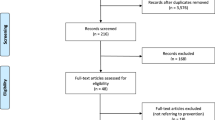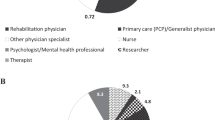Abstract
Study design:
This is a retrospective chart analysis.
Objectives:
The objective of this study was to evaluate the effect of sacral neuromodulation (SNM) in patients with neurogenic lower urinary tract dysfunction (NLUTD).
Settings:
This study was conducted in a spinal cord injury rehabilitation center in Switzerland.
Methods:
The charts of all patients who underwent SNM (testing and/or permanent implantation) because of NLUTD at our institution between 2007 and 2013 were evaluated. Treatment outcomes and complications were recorded.
Results:
A total of 50 patients, 30 women and 20 men, with a mean age of 46 (±14) years, fulfilled the inclusion criteria. The most frequent cause for SNM was spinal cord injury in 35 patients (70%). Median duration of the underlying disease was 9.5 (±9.3) years. In all, 35 patients (70%) received a permanent implant. The complication rate was 16% (8/50). At the last follow-up, SNM was in use in 32 patients. In 26 patients with SNM because of detrusor overactivity, voiding frequency per 24 h was significantly reduced from 9 to 6, and daily pad use rate was significantly improved (2.6 versus 0.6 pads per 24h). On comparing urodynamic assessment of detrusor function before and under SNM, no significant suppression of neurogenic detrusor overactivity (NDO) was detected. In nine patients with chronic neurogenic urinary retention, median postvoid residual urine was significantly reduced from 370 to 59 ml. In all, 94% of the patients were either very satisfied or satisfied with SNM.
Conclusion:
SNM might be an additional therapy option in carefully selected patients with NLUTD. On the basis of our results, urodynamic evaluation before SNM is mandatory, as the procedure does not seem to be suited to significantly alleviate NDO.
Similar content being viewed by others
Log in or create a free account to read this content
Gain free access to this article, as well as selected content from this journal and more on nature.com
or
References
Holstege G, Mouton LJ . Central nervous system control of micturition. Int Rev Neurobiol 2003; 56: 123–145.
Fowler CJ, Griffiths D, de Groat WC . The neural control of micturition. Nat Rev Neurosci 2008; 9: 453–466.
Drake MJ, Fowler CJ, Griffiths D, Mayer E, Paton JF, Birder L . Neural control of the lower urinary and gastrointestinal tracts: supraspinal CNS mechanisms. Neurourol Urodyn 2010; 29: 119–127.
Panicker JN, Menon L, Anandkumar A, Sundaram KR, Fowler CJ . Lower urinary tract symptoms following neurological illness may be influenced by multiple factors: observations from a neurorehabilitation service in a developing country. Neurourol Urodyn 2010; 29: 378–381.
Akkoç Y, Ersöz M, Yıldız N, Erhan B, Alaca R, Gök H et al. Effects of different bladder management methods on the quality of life in patients with traumatic spinal cord injury. Spinal Cord 2013; 51: 226–231.
Bruschini H, Almeida FG, Srougi M . Upper and lower urinary tract evaluation of 104 patients with myelomeningocele without adequate urological management. World J Urol 2006; 24: 224–228.
Peters KM, Kandagatla P, Killinger KA, Wolfert C, Boura JA . Clinical outcomes of sacral neuromodulation in patients with neurologic conditions. Urology 2013; 81: 738–743.
Lay AH, Das AK . The role of neuromodulation in patients with neurogenic overactive bladder. Curr Urol Rep 2012; 13: 343–347.
Sievert KD, Amend B, Gakis G, Toomey P, Badke A, Kaps HP et al. Early sacral neuromodulation prevents urinary incontinence after complete spinal cord injury. Ann Neurol 2010; 67: 74–84.
Kessler TM, La Framboise D, Trelle S, Fowler CJ, Kiss G, Pannek J et al. Sacral neuromodulation for neurogenic lower urinary tract dysfunction: systematic review and meta-analysis. Eur Urol 2010; 58: 865–874.
Amend B, Khalil M, Kessler TM, Sievert KD . How does sacral modulation work best? Placement and programming techniques to maximize efficacy. Curr Urol Rep 2011; 12: 327–335.
Dindo D, Demartines N, Clavien PA . Classification of surgical complications: a new proposal with evaluation in a cohort of 6336 patients and results of a survey. Ann Surg 2004; 240: 205–213.
Schafer W, Abrams P, Liao L, Mattiasson A, Pesce F, Spangberg A et al. Good urodynamic practices: uroflowmetry, filling cystometry, and pressure- flow studies. Neurourol Urodyn 2002; 21: 261–274.
Clavien PA, Barkun J, de Oliveira ML, Vauthey JN, Dindo D, Schulick RD et al. The Clavien-Dindo classification of surgical complications: five-year experience. Ann Surg 2009; 250: 187–196.
Schiefer MA, Freeberg M, Pinault GJ, Anderson J, Hoyen H, Tyler DJ et al. Selective activation of the human tibial and common peroneal nerves with a flat interface nerve electrode. J Neural Eng 2013; 10: 056006.
Gerridzen RG, Thijssen AM, Dehoux E . Risk factors for upper tract deterioration in chronic spinal cord injury patients. J Urol 1992; 147: 416–418.
Lombardi G, Del Popolo G . Clinical outcome of sacral neuromodulation in incomplete spinal cord injured patients suffering from neurogenic lower urinary tract symptoms. Spinal Cord 2009; 47: 486–491.
Chaabane W, Guillotreau J, Castel-Lacanal E, Abu-Anz S, De Boissezon X, Malavaud B et al. Sacral neuromodulation for treating neurogenic bladder dysfunction: clinical and urodynamic study. Neurourol Urodyn 2011; 30: 547–550.
Stohrer M, Blok B, Castro-Diaz D, Chartier-Kastler E, Del Popolo G, Kramer G et al. EAU guidelines on neurogenic lower urinary tract dysfunction. Eur Urol 2009; 56: 81–88.
Nosseir M, Hinkel A, Pannek J . Clinical usefulness of urodynamic assessment for maintenance of bladder function in patients with spinal cord injury. Neurourol Urodyn 2007; 26: 228–233.
Gottsch HP, Miller JL, Yang CC, Berger RE . A pilot study of botulinum toxin for interstitial cystitis/painful bladder syndrome. Neurourol Urodyn 2011; 30: 93–6.
Author information
Authors and Affiliations
Corresponding author
Ethics declarations
Competing interests
The authors declare no conflict of interest.
Rights and permissions
About this article
Cite this article
Wöllner, J., Krebs, J. & Pannek, J. Sacral neuromodulation in patients with neurogenic lower urinary tract dysfunction. Spinal Cord 54, 137–140 (2016). https://doi.org/10.1038/sc.2015.124
Received:
Revised:
Accepted:
Published:
Issue date:
DOI: https://doi.org/10.1038/sc.2015.124
This article is cited by
-
Effects of repetitive functional magnetic stimulation in the sacral nerve in patients with neurogenic detrusor overactivity after suprasacral spinal cord injury: a study protocol for a randomized controlled trial
Trials (2023)
-
Neuromodulation Following Spinal Cord Injury for Restoration of Bladder and Erectile Function
Current Bladder Dysfunction Reports (2023)
-
Update van sacrale neuromodulatie voor functiestoornissen van de lage urinewegen
Tijdschrift voor Urologie (2021)
-
Systematic Literature Review and Meta-Analysis of Sacral Neuromodulation (SNM) in Patients with Neurogenic Lower Urinary Tract Dysfunction (nLUTD): Over 20 Years’ Experience and Future Directions
Advances in Therapy (2021)
-
Evaluation of pre-operative bladder contractility as a predictor of improved response rate to a staged trial of sacral neuromodulation in patients with detrusor underactivity
World Journal of Urology (2021)



